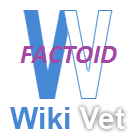Factoid - Anthrax
Key diagnostic tags
Sudden death, Fatal, Bloody discharge, Absence of rigor mortis, Zoonosis
Risk to human health: HIGH
Overview
Anthrax is a potentially fatal bacterial disease of both animals and humans that can be spread from infected dead animal carcases, and can contaminate the ground for decades.
Anthrax bacteria release spores onto the ground (especially when an infected carcass is opened). These spores can survive decades on the soil, and can then infect other animals, or people, that come into contact with them. The disease can be spread between animals, as well as to people, and usually occurs 2-7d after infection. Potentially infected carcases should not be cut open, handled, or eaten, as there is a risk to both animal and human health.
Humans - People can be infected from contact with infected animals, or any body part/fluid from an affected animal. Eating or handling the meat from an infected carcass, or handling the skin or fleece from an infected animal (for example, in leather production or wool processing) can also result in infection. The disease can be fatal in humans.
Signs
In cattle, sheep, goats and horses
- One or two sudden deaths in a herd
- Dark bloody discharge from mouth, nostrils and anus (blood can fail to clot)
- Absence of rigor mortis
- Bloating
- Other signs – DROP DOWN LIST (Sudden temperature, Depression, Neurological signs such as staggering or trembling, Cyanosis, Difficulty breathing, Decrease in stomach movement, Swellings under the skin, reddened or spotty gums, shivering)
In pigs
- Swelling around the head, or neck, which can cause death from not being able to breathe
- An intestinal form is possible, signs are diarrhoea, inappetence and lethargy
In dogs
- Rarely seen, but can get inflammation around the throat and pharynx
Humans - Usually swollen cutaneous lesions (Link) and can also have digestive or inhalation forms.
Diagnosis
- Anthrax should be suspected in cases of sudden death in animals. Possible anthrax cases should not be cut open or eaten as there is a risk to both animal and human health.
- Blood smear (can be taken from ear vein of a carcass) stained with methylene blue will show large numbers of rod shaped bacteria (Link)
Humans - Fluid from cutaneous wounds will show the bacteria in stained smears. Do not cut open, handle, or eat any potentially infected animals.
Treatment and prevention
- Penicillin for affected animals. Treat animals at risk and move to uncontaminated pasture
- Vaccination (Do not use antibiotics within one week of vaccine)
- Disposal of potential anthrax infected carcases (burning the carcass and disinfecting site)
Humans - Antibiotic treatment for 3-7d if uncomplicated, penicillin is a good first choice (Link)
Diseases with similar signs
- Toxin ingestion
- Bacterial or Clostridial infection
- Bloat
- Traumatic injury
- Acidosis
- Any condition resulting in Sudden death
Geotag this disease
Tag here to let others know you suspect a case of this disease
